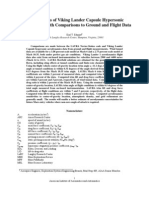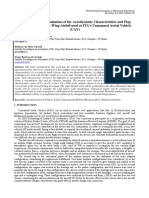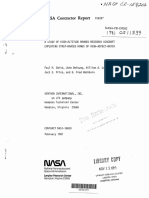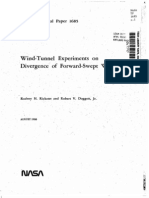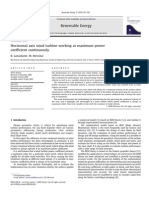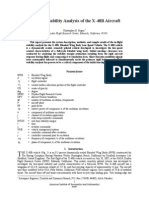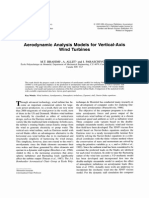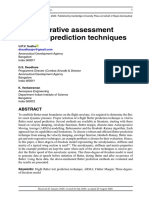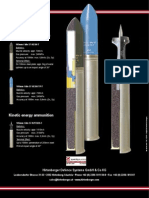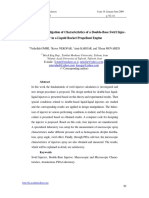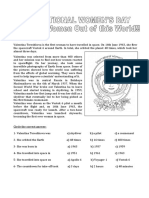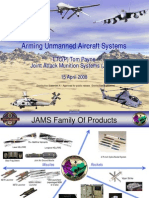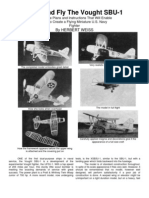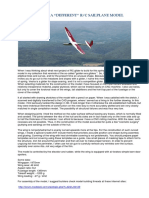Aerodynamic Design of An Extended Range Bomb
Aerodynamic Design of An Extended Range Bomb
Uploaded by
yararaCopyright:
Available Formats
Aerodynamic Design of An Extended Range Bomb
Aerodynamic Design of An Extended Range Bomb
Uploaded by
yararaOriginal Title
Copyright
Available Formats
Share this document
Did you find this document useful?
Is this content inappropriate?
Copyright:
Available Formats
Aerodynamic Design of An Extended Range Bomb
Aerodynamic Design of An Extended Range Bomb
Uploaded by
yararaCopyright:
Available Formats
VOL. 17, NO.
J. AIRCRAFT
JUNE 1980
Aerodynamic Design of an Extended Range Bomb
Randall C. May dew* Sandia Laboratories, Albuquerque, N. Mex.
Abstract
HE extended range bomb (ERB) is designed to provide a low altitude, 15 km stand-off or a 2.5 km turn radius, return-to-target (RTT) delivery capability from aircraft at release speeds of 330-800 KCAS. The boosted, 41.9 cm diameter bomb utilizes two orthogonal pairs of pneumatically actuated canards for attitude control and lift. The guidance and control (G&C) system consists of a strapdown inertial measurement unit (IMU) and a digital computer containing an autopilot and navigator. Extensive wind tunnel tests were conducted to optimize the canard design. Two flight tests of instrumented full-scale vehicles were conducted to verify the design. The wind tunnel data are compared with theory and the verification flight tests are discussed.
Contents
The ERB is designed for external carriage on wing or fuselage pylons on F4, F i l l , A4, A6, and A7 aircraft. Carrier aircraft compatibility (ground and aircraft clearance, ejector racks, release and separation, etc.) severely constrained the size and shape of the aerodynamic lifting and control surfaces on the 3.68 m long bomb. The design1 which evolved (Fig.l) utilizes four extendable fins (for increased lift), fin-tip mounted rollerons, a solid fuel rocket motor, and four canards. Preliminary estimates (1974) of the ERB aerodynamics indicated that lift/drag ratios of 3-5 were achievable. Digital 6 deg of freedom simulations and realtime flight parametric studies on the flight simulator (analog/digital computer) indicated the ERB must pull about 5 g (trim angle of attack of about 15 deg) for the RTT maneuver at Mach 0.9. The simulations also indicated the canards must provide high lift with nearly linear characteristics up to angles of attack (a) of 20 deg. Six component force and moment tests2 of a 0.3 scale 18 deg sweep canard model (Fig. 1) were conducted in the Calspan 2.44 m transonic wind tunnel. The canards were remotely actuated and the canard loads were measured with individual three component balances. Typical normal force coefficient (CN ) data for the 18 deg sweep canards are presented in Fig. 2. The effective angle of attack, as modeled from potential theory and cross-flow considerations, is defined as:
(ogive, hemisphere cone, and hemisphere biconic), canard planform (swept, deltas, and clipped deltas with and without strakes), canard location, and canard cross section. These test data indicated the sphere-cone-cylinder, 60 deg delta-canard forebody was the optimum configuration. Extensive tests were then conducted of a 0.3 scale 60 deg delta-canard model (Fig. 1) in the Calspan transonic wind tunnel. The canard normal force data in Fig. 2 correlates well with the vortex flow theory of Polhamus3; a similar correlation at M=0.90 is shown in Ref. 1. The correction to the wing-alone vortex theory for the effect of the body on the canard normal force was taken from Nielsen.4 Figure 2 illustrates the canard normal force was increased over a factor of two and is nearly linear up to ae =20 deg. The lift contributions of the fins, body, and canards are about 54, 23, and 23%, respectively, for canard deflections of 15 deg at the nominal bomb design trim angle of attack of 15 deg. Approximately 100,000 six-component data points were obtained for the baseline configuration at Calspan at 0.65 <M<1.25, 0 < a < 20 deg, and -15 deg <6< 15 deg. Power series equations were fit to these data using MapleSynge theory and were then input to the flight simulator (hybrid computer) for preflight simulation with evaluation of
FIN ROTATED 14
ALL DIMENSIONS IN INCHES
60 DELTA CANARD MODEL
Fig. 1 Calspan wind tunnel models (0.3 scale).
where dy is the canard deflection in model pitch plane. The canard normal force data collapse to a single curve for various canard deflections when plotted vs ae. The data indicate the 18 deg sweep canards partially stall at ae = 12 deg and do not provide sufficient lift. Hence, it was decided to conduct a parametric test in the Sandia 0.3 m transonic wind tunnel of 0.09 scale canard/forebody configurations. Fortyone models were tested to evaluate the effects of nose shape
Received June 18, 1979; synoptic received Oct. 11, 1979. Full paper available from National Technical Information Service, Springfield, Va. 22151 as N80-13023 at the standard price (available upon request). Copyright American Institute of Aeronautics and Astronautics, Inc., 1979. All rights reserved. Index categories: LV/M Aerodynamics; LV/M Configurational Design; LV/M Testing, Flight and Ground. *Manager, Aerodynamics Department. Associate Fellow AIAA.
NOSE/PLANFORM 1 1 .10.15 OGIVE/18 0 SWEEP BLUNT CONE/600/} o A n <?
_ _ _ _ _ POTENTIAL FLOW POTENTIAL PLUS VORTEX FLOW
Fig. 2 Comparison of canard normal force wind tunnel data with theory for A/= 0.65.
385
386
R.C. MAYDEW
J. AIRCRAFT
(TIME, SEC)
RANGE x 10" FT
Fig. 3 Flight performance of FTU-1.
were released at M=0.84 at about 10,000 ft altitude and tracked by radar and cinetheodolites. Rate gyro, MARS stable platform (roll, pitch, and yaw), triaxial accelerometer, canard position transducer, etc., data were telemetered to the ground receiving station. The payload sections were parachute recovered. The unpowered 493 kg FTU-1 demonstrated the aerodynamics and G&C for the standoff mission. At 4.5 s after release (Fig. 3), the canards were actuated and the guidance system flew the ERB to an imaginary target position 4.57 km (15,000 ft) north of the release point. The autopilot maneuvered the ERB to within 24 ft east error and 6 ft altitude error of the imaginary target. FTU-1 trimmed at a - 8 to 10 deg with canard deflections of about 4 deg. The flight lateral accelerometer data agreed with wind tunnel normal force data within 1-7%. The powered 544 kg FTU-2 demonstrated the aerodynamics and G&C for the RTT mission. The rocket motor provided 4700 Ib thrust for 2.7 s followed by a sustainer with thrust of 675 Ib for about 50 s. At 4.5 s after release the canards were actuated and the unit was programmed to dive about 1000 ft. The rocket motor was ignited at 15 s, and the guidance system flew the unit in a near circular trajectory back to the imaginary target near the release point (Fig. 4). The unit maintained a nearly constant altitude from 20 to 75 s. The trim angle of attack gradually increased from about 15 deg at 20 s to about 20 deg at 75 s; the unit stalled at 32 deg at 80 s. The unit missed the imaginary target by about 15 m (50 ft). The target was offset 305 m (1000 ft) in cross range from the release point (see Fig. 4), i.e., the autopilot commanded the FTU-2 to seek the target. Figure 4 illustrates the good agreement of the FTU-2 RRT simulation with the flight data.
3 DOWNRANGE, KM
Acknowledgment
This work was supported by the U.S. Department of Energy.
Fig. 4 Flight performance of FTU-2.
the G&C system. Initially, the simulations were run with the IMU and canard actuator hardware mathematically modeled on the hybrid. Later simulations included the IMU hardware mounted on the three-axis motion simulator to generate the expected flight angular rates; the IMU signals were then fed to the G&C computer which generated commands for the canard actuators. Typical preflight design change requirements identified were rocket ignition timing, canard actuator gains and damping, and radius-of-turn trajectories for RTT delivery. Further, the compatibility of flight hardware was demonstrated. Two ERB flight tests were conducted with an A-7 aircraft at the Sandia Tonopah Test Range, Nev., in 1977. The test units
References
Maydew, R.C., ''Aerodynamic Design of an Extended-Range Guided Bomb," Sandia Laboratories, Albuquerque, N. Mex., SAND79-0836, Oct. 1979. 2 Reid, C.F., "Transonic Wind Tunnel Force Tests of the Sandia ERB/RTB Model in the CALSPAN 8-Foot Transonic Wind Tunnel," Calspan Corp., Buffalo, N.Y., Calspan Report AA-4034-W-1, Nov. 1975. 3 Polhamus, E.G., "Charts for Predicting the Subsonic Vortex-Lift Characteristics of Arrow, Delta, and Diamond Wings," NASA TN D6243, April 1971. 4 Nielsen, J.N., "Nonlinearities in Missile Aerodynamics," AIAA Paper 78-20, AIAA 16th Aerospace Sciences Meeting, Huntsville, Ala., Jan. 16-18, 1978.
]
You might also like
- Speed, Velocity and Acceleration CalculationsDocument3 pagesSpeed, Velocity and Acceleration CalculationsAndro100% (2)
- Lab 7 DraftDocument22 pagesLab 7 Draftapi-252392235No ratings yet
- MEC 102 PS 1st Term-2011-2012Document3 pagesMEC 102 PS 1st Term-2011-2012Mond DamascoNo ratings yet
- Stability in Hovering Ornithopter FlightDocument8 pagesStability in Hovering Ornithopter FlightgreatrijuvanNo ratings yet
- 2006249454Document20 pages2006249454sh_nk2010No ratings yet
- UH-60 Blackhawk NASA TestsDocument18 pagesUH-60 Blackhawk NASA TestsmaverickF15No ratings yet
- Oblique Wing Aerodynamics: U.S. Army Aviation and Missile Research Development and Engineering CenterDocument3 pagesOblique Wing Aerodynamics: U.S. Army Aviation and Missile Research Development and Engineering Centertolomeo10No ratings yet
- COBEM2007 UavDocument10 pagesCOBEM2007 UavFred FreddyNo ratings yet
- Chaney 1992Document17 pagesChaney 1992128mansouriNo ratings yet
- DantskerCaccamoDetersSelig 2020 AIAA Paper 2020 2762 CamPropsTestingDocument52 pagesDantskerCaccamoDetersSelig 2020 AIAA Paper 2020 2762 CamPropsTestingErhan FeyzioğluNo ratings yet
- Rolling Rig Aiaa17Document13 pagesRolling Rig Aiaa17chandu dhaduvaiNo ratings yet
- Uav PropollerDocument13 pagesUav Propolleramir_karimiNo ratings yet
- Active Flaps and Slats For Rotor Performance EnhancementDocument17 pagesActive Flaps and Slats For Rotor Performance EnhancementKumar RavichandranNo ratings yet
- A Study of High-Altitude Manned Research Aircraft Employing Strut-Braced Wings of High-Aspect-Ratio - NASA CR-159262 - Smith, DeYoung, Lovell, Price, WashburnDocument94 pagesA Study of High-Altitude Manned Research Aircraft Employing Strut-Braced Wings of High-Aspect-Ratio - NASA CR-159262 - Smith, DeYoung, Lovell, Price, WashburnodehNo ratings yet
- Wartime Report: National Advisory Committee For AeronauticsDocument27 pagesWartime Report: National Advisory Committee For AeronauticsasimaliabbasiNo ratings yet
- AIAA2008 Ballmann SmallDocument15 pagesAIAA2008 Ballmann SmallAndreea BoboneaNo ratings yet
- Divergence of FSWDocument50 pagesDivergence of FSWkingroy2377100% (1)
- Performance and Design Investigation of Heavy Lift Tiltrotor With Aerodynamic Interference EffectsDocument19 pagesPerformance and Design Investigation of Heavy Lift Tiltrotor With Aerodynamic Interference EffectsJr Zdenko VukojaNo ratings yet
- Bousman TMDocument56 pagesBousman TMTarak Nath NandiNo ratings yet
- NASA 1972 Prop Noise Ham STD FortranDocument78 pagesNASA 1972 Prop Noise Ham STD FortranRuben E. PerezNo ratings yet
- Extrenal AerodynamicsDocument18 pagesExtrenal AerodynamicsLuis Rubio GómezNo ratings yet
- NASA Report - Theory For Computing Span Loads and Stability Derivatives Due To Side Slip, Yawing, and Rolling For Wings in Subsonic Compressible FlowDocument79 pagesNASA Report - Theory For Computing Span Loads and Stability Derivatives Due To Side Slip, Yawing, and Rolling For Wings in Subsonic Compressible Flowmssj87No ratings yet
- Aerodynamic Design of The Space ShuttleOrbiterDocument24 pagesAerodynamic Design of The Space ShuttleOrbiteredward.rhodes4760No ratings yet
- Avionics System For A Small Unmanned Helicopter Performing Agressive ManeuversDocument7 pagesAvionics System For A Small Unmanned Helicopter Performing Agressive ManeuversAnas NassarNo ratings yet
- Aerodynamic Performance of Propellers 1245Document11 pagesAerodynamic Performance of Propellers 1245mikewenNo ratings yet
- A Comparative Study On 6-DOF Trajectory Simulation of A Short Range Rocket Using Aerodynamic Coefficients From Experiments and Missile DATCOMDocument10 pagesA Comparative Study On 6-DOF Trajectory Simulation of A Short Range Rocket Using Aerodynamic Coefficients From Experiments and Missile DATCOMddeshkar8659No ratings yet
- Potsdam1 AHS04Document13 pagesPotsdam1 AHS04amir_karimiNo ratings yet
- Model-Based Wind Estimation For A Hovering VTOL Tailsitter UAVDocument8 pagesModel-Based Wind Estimation For A Hovering VTOL Tailsitter UAVcesarNo ratings yet
- Aiaa 2009 4887Document12 pagesAiaa 2009 4887amin_127No ratings yet
- Modeling and Backstepping-Based Nonlinear ControlDocument9 pagesModeling and Backstepping-Based Nonlinear Controloussama sadkiNo ratings yet
- Control Surfaces Hinge Moment Calculation For High Aspect Ratio WingDocument27 pagesControl Surfaces Hinge Moment Calculation For High Aspect Ratio WingPaulo HenriqueNo ratings yet
- Simulating Quadrotor UAVs in Outdoor ScenariosDocument7 pagesSimulating Quadrotor UAVs in Outdoor ScenariosRodolfo Castro E SilvaNo ratings yet
- Bousman ERF00 PDFDocument21 pagesBousman ERF00 PDFrahpooye313No ratings yet
- Hauser Vs To L Aircraft 1992Document15 pagesHauser Vs To L Aircraft 1992Francisco Liszt Nunes JuniorNo ratings yet
- Horizontal Axis Wind Turbine Working at Maximum Power Coefficient ContinuouslyDocument6 pagesHorizontal Axis Wind Turbine Working at Maximum Power Coefficient ContinuouslyLiviu MateescuNo ratings yet
- A Technique To Determine Lift and Drag Polars in FlightDocument7 pagesA Technique To Determine Lift and Drag Polars in Flightmykingboody2156No ratings yet
- Narathepp,+255612190825 - 53 Js Crma P 127 135Document9 pagesNarathepp,+255612190825 - 53 Js Crma P 127 135Zaya TunNo ratings yet
- Technical ReportDocument36 pagesTechnical ReportRithik GowdaNo ratings yet
- Aiaa 2005 5086 424Document19 pagesAiaa 2005 5086 424arash0000No ratings yet
- Aircraft Control SystemsDocument10 pagesAircraft Control Systemsmac_08No ratings yet
- Extended Abstract 83675Document10 pagesExtended Abstract 83675Hoàng ThiếtNo ratings yet
- Taylor 1992Document16 pagesTaylor 1992128mansouriNo ratings yet
- Numerical Simulation of A Flow Around An Unmanned Aerial VehicleDocument4 pagesNumerical Simulation of A Flow Around An Unmanned Aerial VehicleGeoff BranniganNo ratings yet
- Flight MeasurementsDocument29 pagesFlight MeasurementsewiontkoNo ratings yet
- Flight Control For Target Seeking by 13 Gram OrnithopterDocument8 pagesFlight Control For Target Seeking by 13 Gram OrnithopterkidzniaNo ratings yet
- Identification of Sharp Edge Non-Slender Delta Wing Aerodynamic Coefficient Using Neural NetworkDocument8 pagesIdentification of Sharp Edge Non-Slender Delta Wing Aerodynamic Coefficient Using Neural NetworkFahmi IzzuddinNo ratings yet
- Calculation of The Aerodynamic Behavior of The Tilt Rotor Aeroacoustic Model (TRAM) in The DNWDocument37 pagesCalculation of The Aerodynamic Behavior of The Tilt Rotor Aeroacoustic Model (TRAM) in The DNWTimothy JimNo ratings yet
- Wartime: National AdvisoryDocument30 pagesWartime: National AdvisoryKeith WarlickNo ratings yet
- A Procedure For Propeller Design by Inverse MethodsDocument12 pagesA Procedure For Propeller Design by Inverse MethodsMuadz MuhammadNo ratings yet
- PID For Fixed-Wing UAV PDFDocument6 pagesPID For Fixed-Wing UAV PDFMUVNNo ratings yet
- Hover Copter AnalysisDocument3 pagesHover Copter AnalysisGustavo Nárez Jr.No ratings yet
- Design, Development and Testing of Low-Cost Force Balance For Wind TunnelDocument12 pagesDesign, Development and Testing of Low-Cost Force Balance For Wind TunnelSatya SuryaNo ratings yet
- Aerodynamic Analysis Models For Vertical-Axis Wind TurbinesDocument8 pagesAerodynamic Analysis Models For Vertical-Axis Wind TurbinesEminNo ratings yet
- Wind-Tunnel Tests of A Series of Parachutes Designed For Controllable Gliding FlightDocument42 pagesWind-Tunnel Tests of A Series of Parachutes Designed For Controllable Gliding FlightMohd NaimuddinNo ratings yet
- A Comparative Assessment of Flutter Prediction TechniquesDocument34 pagesA Comparative Assessment of Flutter Prediction TechniquesTheNo ratings yet
- Smartbird LayoutDocument9 pagesSmartbird LayoutFrancuzzo DaniliNo ratings yet
- 8 ETC 2011 AA CC Jan 2011Document11 pages8 ETC 2011 AA CC Jan 2011AerospaceAngelNo ratings yet
- Ducted Fan Used in VTOL Uav SystemsDocument11 pagesDucted Fan Used in VTOL Uav SystemsHenrik13100% (3)
- Aerodynamic Analysis of A Rocket Configuration With Grid FinDocument5 pagesAerodynamic Analysis of A Rocket Configuration With Grid FinKhoa Vũ100% (1)
- Biber - 2004 - Supercrit Airfoil Desgn Future HALEDocument9 pagesBiber - 2004 - Supercrit Airfoil Desgn Future HALEJasoos ParrierNo ratings yet
- Modeling of Complex Systems: Application to Aeronautical DynamicsFrom EverandModeling of Complex Systems: Application to Aeronautical DynamicsNo ratings yet
- Squashhead Ammunition: 105mm / Mle 57 HESH-TDocument4 pagesSquashhead Ammunition: 105mm / Mle 57 HESH-TyararaNo ratings yet
- Research Article: Transient Burning Rate Model For Solid Rocket Motor Internal Ballistic SimulationsDocument11 pagesResearch Article: Transient Burning Rate Model For Solid Rocket Motor Internal Ballistic SimulationsyararaNo ratings yet
- 07 - 3 - New York - 09-63 - 0083Document25 pages07 - 3 - New York - 09-63 - 0083yararaNo ratings yet
- D R A G Coefficient Curve Identification of Projectiles From Flight Tests Via Optimal Dynamic Fitting 1Document10 pagesD R A G Coefficient Curve Identification of Projectiles From Flight Tests Via Optimal Dynamic Fitting 1yararaNo ratings yet
- Experimental Investigation of Characteristics of A Double-Base Swirl Injec-Tor in A Liquid Rocket Propellant EngineDocument20 pagesExperimental Investigation of Characteristics of A Double-Base Swirl Injec-Tor in A Liquid Rocket Propellant EngineyararaNo ratings yet
- Design Optimization of Solid Propellant Rocket Motor Pavel Konečný, Vojtěch Hrubý, Zdeněk KřižanDocument8 pagesDesign Optimization of Solid Propellant Rocket Motor Pavel Konečný, Vojtěch Hrubý, Zdeněk KřižanyararaNo ratings yet
- Rocket Motor With Tubular Solid Propellant Charge and Profiled Outer SurfaceDocument12 pagesRocket Motor With Tubular Solid Propellant Charge and Profiled Outer SurfaceyararaNo ratings yet
- WSRL-0146-TR PRDocument18 pagesWSRL-0146-TR PRyararaNo ratings yet
- Defence Research Reports: CitationDocument3 pagesDefence Research Reports: CitationyararaNo ratings yet
- Analytical Prediction of Trajectories For High-Velocity Direct-Fire MunitionsDocument72 pagesAnalytical Prediction of Trajectories For High-Velocity Direct-Fire MunitionsyararaNo ratings yet
- An Automated Method For Computer Vision Analysis of Cannon-Launched Artillery VideoDocument12 pagesAn Automated Method For Computer Vision Analysis of Cannon-Launched Artillery VideoyararaNo ratings yet
- Effect of Mach Number On Supersonic Wrap Around Fin AerodynamicsDocument6 pagesEffect of Mach Number On Supersonic Wrap Around Fin AerodynamicsJuanita CopelandNo ratings yet
- ASA Data Book PDFDocument923 pagesASA Data Book PDFkayshephNo ratings yet
- Nazi Moon BaseDocument5 pagesNazi Moon Baseomkar100% (1)
- STS47Document12 pagesSTS47Kom WongsawatNo ratings yet
- L2 U12 La RCDocument2 pagesL2 U12 La RClisett_sarmientoNo ratings yet
- Sa Cup Ims-20230920Document18 pagesSa Cup Ims-20230920YashNo ratings yet
- Space Women Reading Comprehension ExercisesDocument2 pagesSpace Women Reading Comprehension ExercisesnatachalequeuxNo ratings yet
- DA PAM 385-63 Range SafetyDocument216 pagesDA PAM 385-63 Range SafetyRyan ScottNo ratings yet
- Kampfflieger - Stinson L5 Sentinel 87Document12 pagesKampfflieger - Stinson L5 Sentinel 87Darren-Edward O'NeillNo ratings yet
- 1151AE110COMPRESSIBLEFLOWAERODYNAMICSDocument3 pages1151AE110COMPRESSIBLEFLOWAERODYNAMICSEMON KONDAKERNo ratings yet
- Arming UAVDocument7 pagesArming UAVjan_256No ratings yet
- Manual PanelDocument4 pagesManual PanelantplaNo ratings yet
- PDF Notes and Tips: A-7 Corsair JetDocument20 pagesPDF Notes and Tips: A-7 Corsair JetAlexandra SpătăreluNo ratings yet
- Water RocketsDocument24 pagesWater RocketsShubham MauryaNo ratings yet
- Proposal Work Industrial Visit To Spirit Aerosystems Malaysia SDN BHD Organized byDocument8 pagesProposal Work Industrial Visit To Spirit Aerosystems Malaysia SDN BHD Organized byPurawin SubramaniamNo ratings yet
- Aerodynamics of Vertical Landing Rocket Vehicle With Engine Thrust in Landing PhaseDocument9 pagesAerodynamics of Vertical Landing Rocket Vehicle With Engine Thrust in Landing PhaseJesus Eduardo Duran DelfinNo ratings yet
- Fuel System A320 QuestionsDocument5 pagesFuel System A320 Questionsricardo4navarro-4100% (2)
- Flow Visualization Around A Double Wedge Airfoil Model With Focusing Schlieren SystemDocument2 pagesFlow Visualization Around A Double Wedge Airfoil Model With Focusing Schlieren SystemKumaraShanNo ratings yet
- Arroz Con Mango - Vol 2Document1 pageArroz Con Mango - Vol 2Wilfrido MolinaresNo ratings yet
- Physics I Problems PDFDocument1 pagePhysics I Problems PDFbosschellenNo ratings yet
- Fluid and Power Products 757Document6 pagesFluid and Power Products 757Panagiotis DiakidisNo ratings yet
- British Aerospace EAPDocument3 pagesBritish Aerospace EAP224883061No ratings yet
- Mahan Air Purchase Avro RJDocument6 pagesMahan Air Purchase Avro RJErin BancoNo ratings yet
- Design of A Rocket Injector For A Liquid Ver2Document26 pagesDesign of A Rocket Injector For A Liquid Ver2ayushNo ratings yet
- Vought SBU-1 BomberDocument7 pagesVought SBU-1 BomberAviation/Space History LibraryNo ratings yet
- PVC Rocket Motor - How To Make It - DiyDocument5 pagesPVC Rocket Motor - How To Make It - Diysnoopinaround100% (1)
- VESNA Sailplane Assembly InstructionsDocument7 pagesVESNA Sailplane Assembly InstructionsFloria BogdanNo ratings yet
- Lab 8 Notes - Basic Aircraft Design Rules: H V H V H H VDocument8 pagesLab 8 Notes - Basic Aircraft Design Rules: H V H V H H VRia Jiot100% (1)
- Generalized Trim: 3.1 Denition and Solution of The Trim ProblemDocument5 pagesGeneralized Trim: 3.1 Denition and Solution of The Trim ProblemGiovanni GozziniNo ratings yet




